Samtal med Yellow Jacket Collective
April 2023, Ingeborg Zackariassen
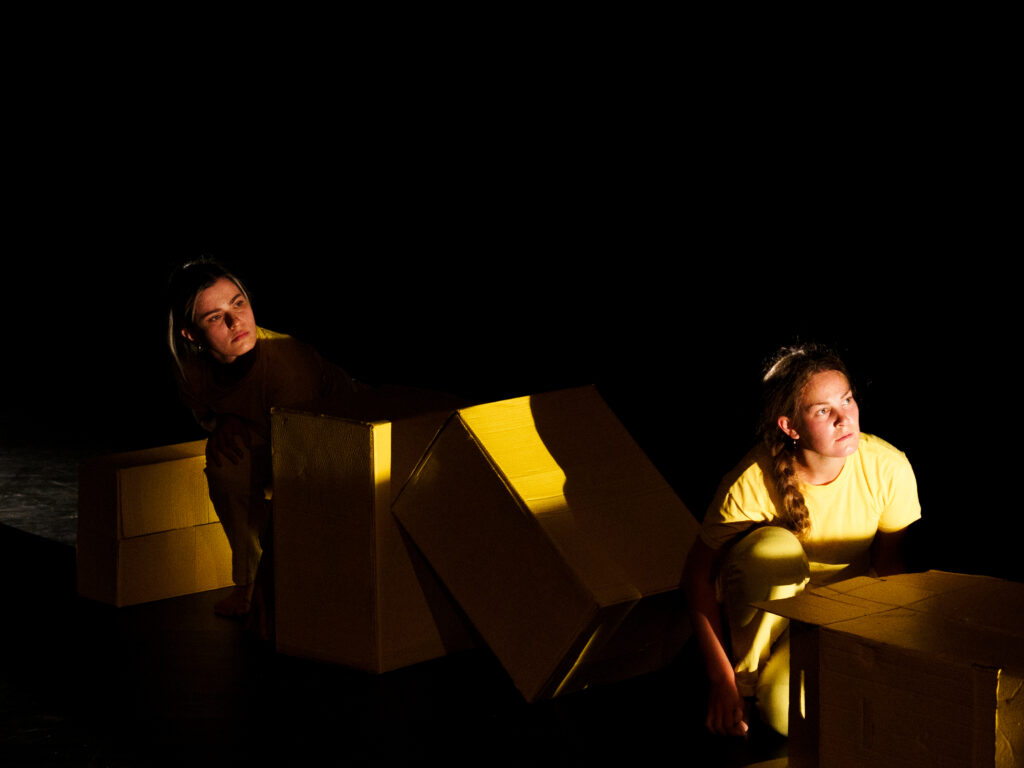
It’s Easter, and I get to meet the digital versions of Rannhvi Mebius Jormin and Amélie Roch of Yellow Jacket Collective.
We are having a video call to talk about their piece “Yellow – we’re halfway there”, which will be shown in 3:e Våningen in a few days.
The last time (which also happened to be the first time) I saw Rannhvi, we were actually improvising together in front of a small audience in Linda Wardal’s piece “A Study of Choices” at 3:e Våningen. That was about two years ago, exactly around the moment in time when Yellow Jacket Collective was about to take shape.
Rannhvi has since graduated from Copenhagen Contemporary Dance School and moved to Stockholm.
Right now, though, she is situated on the island of Brännö outside Gothenburg. Her sunny face is translated into smiling pixels on my computer screen. She is telling me that the starting point of it all is the color yellow. They have gathered together references and associations; everything they could think of that goes hand in hand with the color.
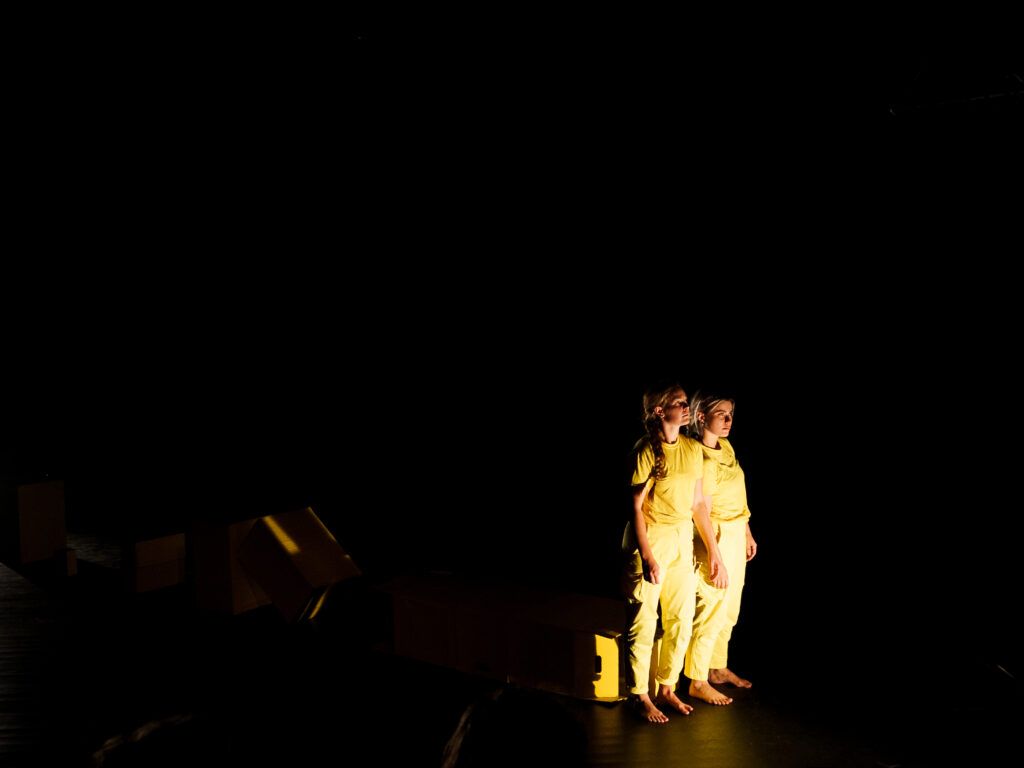
– All the material in the piece come from different starting points and aspects of the color yellow, and then we put all of it together like a mosaic, that together creates a yellow universe.
I ask if this is their first piece as a collective. Amélie Roch, who is based in France and Sweden, and who is the second half of the founding members of Yellow Jacket Collective, clarifies:
– Well, we created one piece together before this, in Copenhagen. That’s where we met, and where we studied together. Back then it was a trio, though. We both graduated in 2020, and then went on to create the collective.
“Yellow – we’re halfway there” was the first piece we made as a duo, and the starting point of the trilogy that we’re making now. We started with “Yellow”, then we have “Blue”, and then in the end of April we’re starting the last piece, which is called “Red”.
The trilogy is named Prisma. Since yellow, red, and blue are the primary color in visual arts – we know there are different primary colors depending on the medium- they also set the base for the collective. Giving a wide enough opportunity to create, it still sets a very clear frame, which is so interesting to create with.
It is very, very wide; color is everywhere; but at the same time, it’s very clear what we have to do, and as Rannhvi said, it’s an accumulation of all the references and associations, and when we put them all together, it creates a very abstract but clear story, which is made possible by having the color as the center of the process.
I am curious about the initial color-choice, yellow, which is also the name of their collective.
What’s the story behind it? How come the color yellow became the starting point?
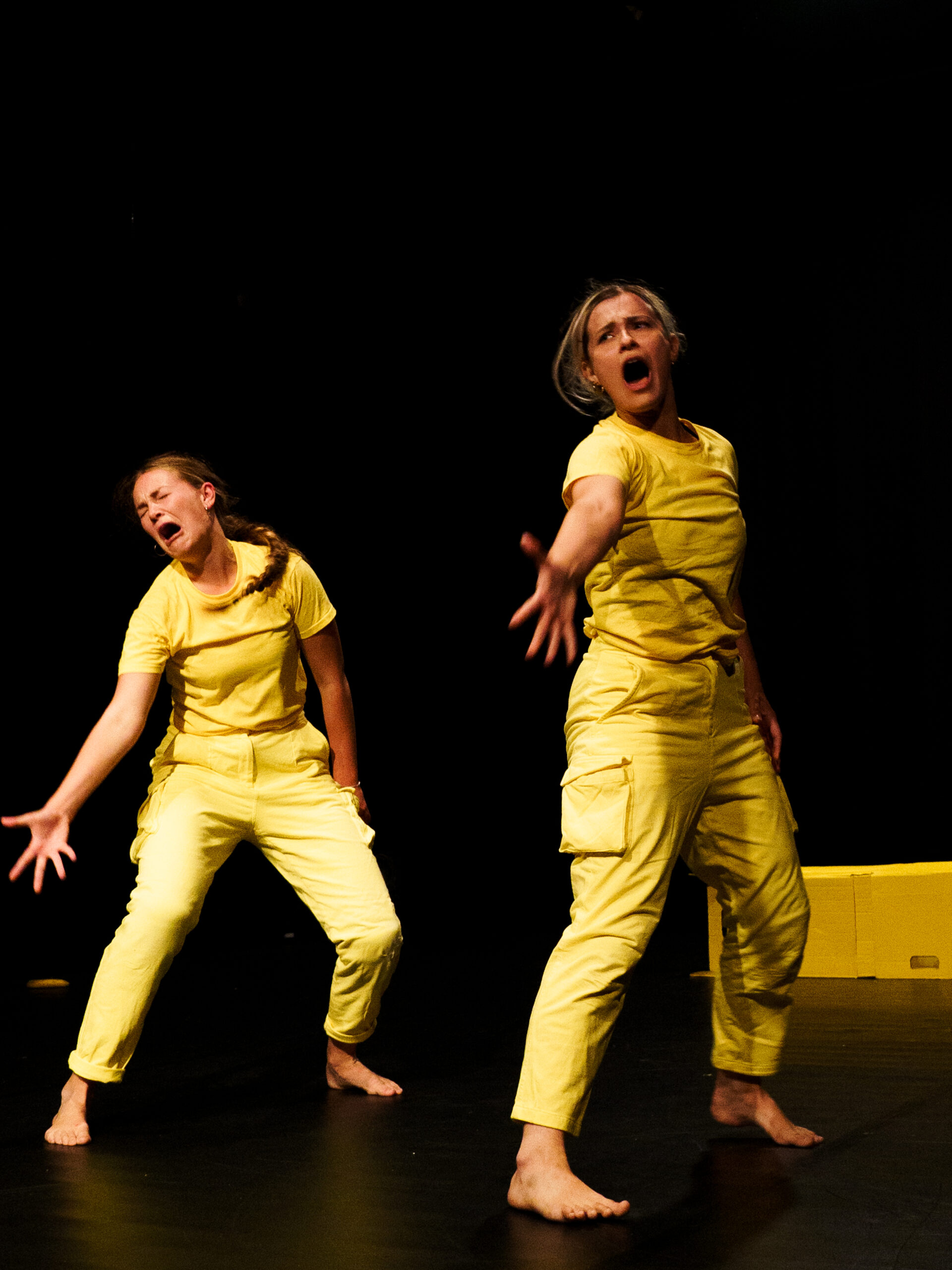
Rannhvi responds:
– Since we graduated into the pandemic, we were a bit lost, and we had a phone call where we just decided to create something together. Then we thought about what we had in common, the two of us. There’s this little story about a yellow jacket that a common friend of ours had. We both loved this jacket very much and gave many compliments about it and in the end this friend promised the jacket to Amelie, but as it was left in my apartment, I started using it. I had to give it back to Amelie, but we thought about this jacket, and we said, “Obviously we both love the color yellow, so why not use it as the starting point of this creation?”
Amélie shoots in:
– Yeah, and that story gave us the name of the collective actually.
I mention a vague memory I have of a song about a yellow jacket, and Amélie immediately responds:
– Oh, there are so many different things named yellow jacket! If you search online, you’ll find that there’s a wasp called yellow jacket, there’s the social movement in France, there’s an activist group in the United States, there’s a jazz band, there’s a Marvel hero… there are many things called yellow jacket… and we like it that way.
I ask about the way they work; do they use improvisation as a tool?
Amélie:
– Yes, we do, and for this trilogy, Prisma, the scenography also plays a big part, because it will influence the movement, and how the space is constructed and what it says, so for Yellow we have seven cardboard boxes, which we had before we started creating the movement. The boxes were painted, and we knew they were going to be a big influence. The movement and the scenography are built together to create the images and to translate the associations and references that we had already written down.
Rannhvi:
– We always start off with a big brainstorming of different references to the color we work with, and then we make a task from one of these aspects of the color. For example, it could be the fact that stop signs are yellow. Then we create a (physical, red. anm.) task where we’re working with stops, and then we use it in instant composition.
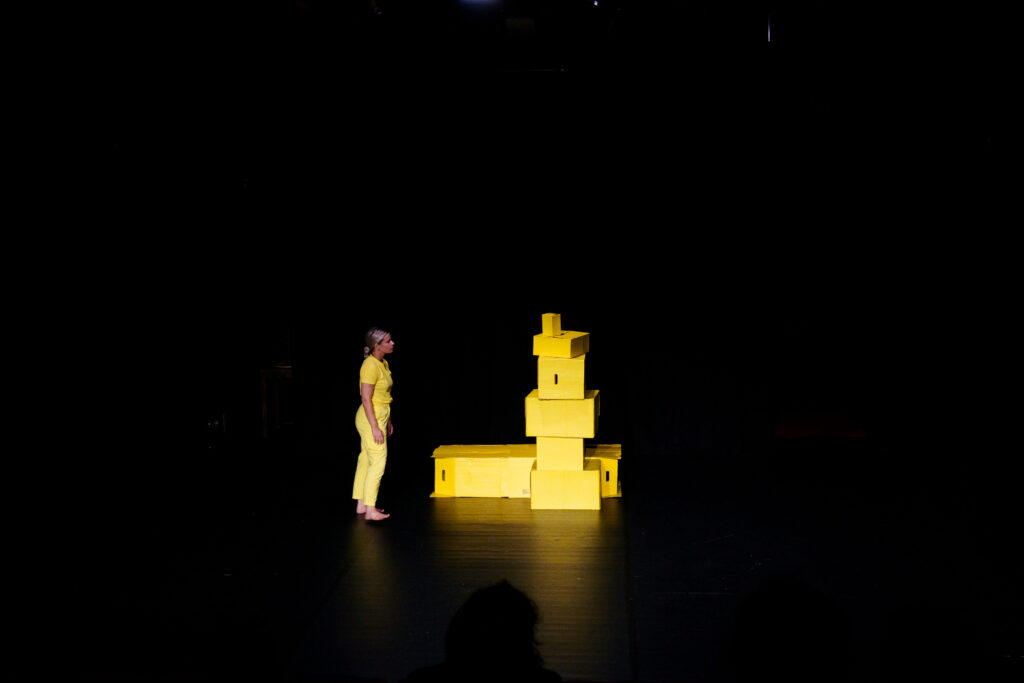
Amélie:
– The way we work with instant composition is that we create a lot of things together, and then we bounce off each other; what the other has to offer; so, it becomes a hybrid movement language that is a mix of both of us. Creating as a duo is a very symbiotic thing. It’s instant in the sense of that it is very much based on the feeling of the moment, and obviously the feeling and how we do things are influenced by all the brainstorming we did before and putting yourself into this mood that is emulated by the color. With yellow it was a lot of happiness and joy and summer, and also we ask other people what they feel about the color, because we want to get a bit of a picture of what the collective imagination around the color is. We use this state to compose, and as Rannhvi said, have specific focus points as well. We found out that yellow was used as temporary signs for the roads and construction work, but how can we use this with the body- how can we say it? Yellow is also the color of sickness, a sign of malfunction in the body. So, we have a more “disgusting” part (in the piece, red. anm.) as well, to illustrate the full range of the color.
I ask about the term “collective” in their name, and whether or not they see their work expanding beyond the duo of “Yellow”.
Rannhvi:
– Yes, we started just the two of us, but the vision has always been to be more, and not only dancers, but also from other disciplines. Slowly it’s becoming bigger and bigger. Since this is our first piece, it’s just the two of us (on stage, red. anm.), but even in this one there was a small collaboration, with the costume designer. For the second piece, “Blue”, we have a musician with us. So we are slowly becoming more and more.
I always wonder what other artists find challenging or fruitful when working collectively, so I ask Rannhvi and Amélie, what pros and cons they’re experiencing when working as a duo.
Rannhvi:
– I find it very interesting, because sometimes you would get an idea, but it never becomes what you imagined, because there’s someone else who’s influencing and thinking as well. You never know what is going to happen. Sometimes you don’t really trust an idea, but then you go for it anyway, and then suddenly it becomes something that you couldn’t have thought of yourself. So that’s the pros, but then of course the cons are that it can be very challenging to collaborate sometimes, when you have two strong wills. You have to find a balance, and let everyone be equal; not have one taking over; so you always have to keep working on trusting each other. That’s the biggest thing. To trust that “ok, you have this idea, then I will go with you down this road”.
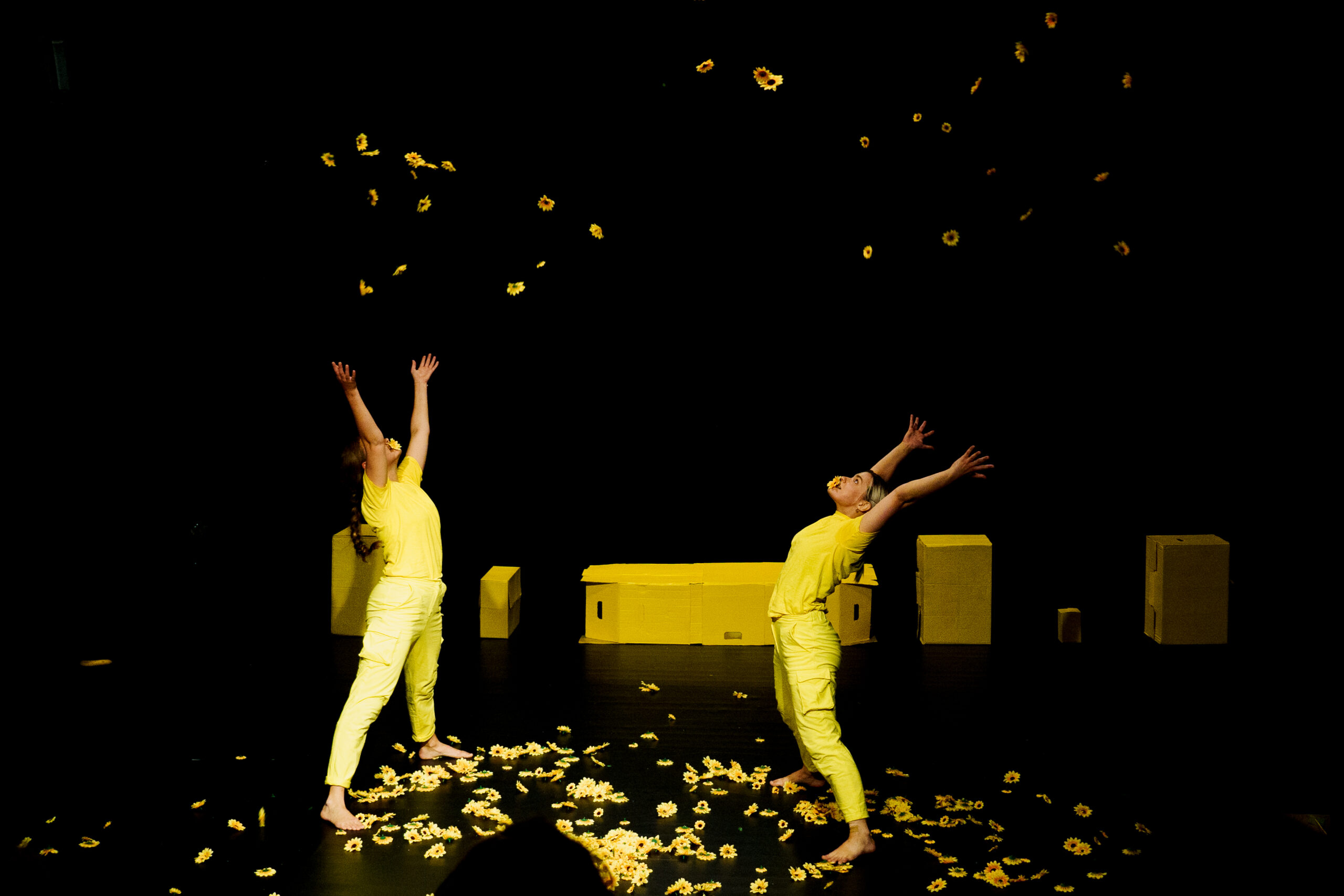
Amélie:
– Yes, it’s about balance, and about letting go of your ego. Some ideas might not become what you expect, or you may have to let go of an idea because you are collaborating without hierarchy, which is something very important to us; that everyone that is in the artistic process has the same voice. You need to really dive in with the other person and really trust them. You are not in their head, so you can’t see what their vision is, but you have to just be there for the ride and see it come to life as it goes on.
Yellow Jacket Collective’s second piece, “Blue”, which is the second part of the trilogy Prisma, premiered in February in Kungsbacka. It was co-produced by Rum för Dans and is a three-part piece. It has a short outside version, a version premiering in the autumn for kids aged 4-7 and “Blue – turning tide”, a black box-version, which is a direct continuation of the first piece, following the same format as “Yellow – we’re halfway there”.
The process of last part of the trilogy, “Red” is about to start in the end of April, with a research residency.
Who knows what else the future will bring. One thing seems clear though; Yellow Jacket Collective is bursting with energy and ready to expand their palette.
Photos: @pyttipanna_official.jp